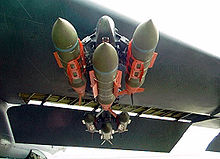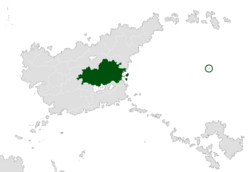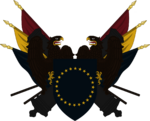User:Greater Carloso/Sandbox 3

The R550-series of general-purpose bombs are a modular family of air-dropped explosives widely utilised by the Carlosian Armed Forces. They range from the 250 lb R551 to the 4,000 lb R555. In recent years, they have been upgraded with Accuracy & Stand-off Rectification (ASOR) guidance and wing modules which have converted them into precision-guided glide bombs. Initially effective against stationary targets, the addition of laser seekers in combination with ASOR allow them to effectively eliminate moving targets as well.
Variants
R551 250 lb bomb
| R551 250 lb bomb | |
|---|---|
| Type | General-purpose bomb |
| Place of origin | |
| Service history | |
| Used by | Carlosian Armed Forces |
The R551 is the smallest of the R550-series bombs, comparable to the Mark 81 utilised by some countries. It's low yield resulted in many military officers doubting its necessity, however it proved useful in situations where the limitation of collateral damage was desirable, such as the during the Liberation of Victory when the Carlosian Air Force sought to liquidate Bourgougian units within the city without compromising the integrity of surrounding high-rise buildings. It's use has continued up to the present day, and has been substantially upgraded with the use of ASOR modules.
R552 500 lb bomb
| R552 500 lb bomb | |
|---|---|
| Type | General-purpose bomb |
| Place of origin | |
| Service history | |
| Used by | Carlosian Armed Forces |
R553 1,000 lb bomb
| R553 1,000 lb bomb | |
|---|---|
| Type | General-purpose bomb |
| Place of origin | |
| Service history | |
| Used by | Carlosian Armed Forces |
R554 2,000 lb bomb
| R554 2,000 lb bomb | |
|---|---|
| Type | General-purpose bomb |
| Place of origin | |
| Service history | |
| Used by | Carlosian Armed Forces |
R555 4,000 lb bomb
| R555 4,000 lb bomb | |
|---|---|
| Type | General-purpose bomb |
| Place of origin | |
| Service history | |
| Used by | Carlosian Armed Forces |
With an ASOR kit, it is comparable to the KAB-1500S-E. The penetrator version is often equipped with a solid-rocket motor to increase velocity in the final stages of its descent, thus significantly improving its penetrating power.
See also
TBD
| Greater Carloso/Sandbox 3 | |||
|---|---|---|---|
| |||
| Belligerents | |||
|
Supported by: | |||
| Commanders and leaders | |||
|
| |||
| Units involved | |||
|
Carlosian Armed Forces
| |||
Barssois
Republic of Barssois | |
|---|---|
|
Flag | |
 Location of Barssois (dark green) in Musgorocia (grey) – [Legend] | |
| Capital and largest city | Nouvelle Bar |
| Official languages | French |
| Demonym(s) | Bar |
| Government | Unitary semi-presidential constitutional republic |
| Legislature | National Assembly |
| Population | |
• 2022 census | 125,376,749 |
| HDI (2022) | very high |
| Currency | Bar livre (B₶) (BLV) |
| Date format | dd/mm/yyyy (AD) |
| Driving side | right |
| Internet TLD | .ba |
Barssois, officially the Republic of Barssois is a sovereign unitary semi-presidential constitutional republic located in eastern Musgorocia. Barssois is the largest country in Musgorocia and the second-most populous after Carloso with a population of 125,376,749. Besides its territory in mainland Musgorocia, Barssois also controls Île Solitaire, an isolated island located far to the east in the Libere Ocean.
Victory
City of Victory | |
|---|---|
|
Flag | |
| Official languages | English |
| Demonym(s) | Victorian |
| Government | Unitary parliamentary constitutional republic |
| Legislature | City Assembly |
| Population | |
• 2022 census | 386,953 |
| GDP (nominal) | 2022 estimate |
• Per capita | $97,462 |
| Gini (2022) | medium |
| HDI (2022) | very high |
| Currency | Victorian dero (V£) Carlosian dero (D£) |
| Date format | dd/mm/yyyy (AD) |
| Driving side | left |
| Internet TLD | .vi |
Victory, officially the City of Victory, is a city-state in South Western Musgorocia. It is the smallest sovereign state in Musgorocia by land area and the second least populous; second only to Novaria, though it is by far the most densely populated. Located on the strategically important Victorian Peninsula, it borders the Novarian Ocean to the south, Bourgougia to the north and west, and shares a small land border with Thouthen to the east. Since the beginning of the twenty-first century, its land area has grown by about 10.2% thanks to land reclamation projects.
It is governed as a unitary parliamentary constitutional republic, with a unicameral City Assembly acting as a legislature. The Executive Council is headed by a Prime Minister who is both head of government and ex officio head of state.
Victory continued to be administered as a directly-governed overseas territory of Carloso following the dissolution of the Carlosian Empire. Following extensive rebuilding efforts during the late 1980s and early 1990s after the destruction wrought by the Bourgougian Blitz, the Carlosian government announced a plebiscite on Victory's future status as a Carlosian territory. Ultimately, a very narrow majority of 50.93% voted in favour of independence, formally becoming its own country at a handover ceremony on 1 August 1995. Victory maintains numerous links with Carloso, which is by far its most important trade partner. It's currency, the Victorian dero, is pegged to the Carlosian dero, which is still widely accepted in the city. Carloso also maintains a large military base there.
Due to the actions of Bourgougian forces in the Blitz, relations with Victory are incredibly hostile, with Bourgougia still maintaining its claim over the peninsula. Relations with Thouthen are also very poor. As a result, the entirety of Victory's land border is closed and an extensive network of fortifications, minefields and other defences have been erected, jointly manned by the Victorian Defence Forces and the Carlosian Armed Forces.
Days of May
| Days of May | |||||||
|---|---|---|---|---|---|---|---|
 Imperial Army forces on the streets of Madrigal. | |||||||
| |||||||
| Belligerents | |||||||
|
|
| ||||||
| Commanders and leaders | |||||||
|
|
| ||||||
| Strength | |||||||
| 350,000 soldiers | 150,000 soldiers | ||||||
| Casualties and losses | |||||||
| 97 killed | 185 killed | ||||||
| 102 civilians killed | |||||||
The Days of May, sometimes referred to as the Carlosian Proto-Civil War, was a brief conflict fought from 21 May to 29 May 1932 between forces loyal to the Emperor of Carloso, Sébastien II, and forces aligned to the republican President of the Imperial Council Jerónimo Fonseca. The crisis began when Sébastien's forces ordered the arrest of Fonseca in response to his plan to hold a referendum on the abolishing of the monarchy later in the year. Narrowly escaping, Fonseca rallied his supporters in Valderosa, while large portions of the Imperial Armed Forces defected. Within hours, clashes had broken out across Carloso, while Sébastien dissolved the Imperial Assembly and implemented absolute rule. Major cities across Carloso quickly saw major fighting break out between the factions, while criminal elements took advantage of the situation, looting and raiding banks. Ultimately, Sébastien dashed expectations when he abdicated on 29 May 1932, wishing to avoid the conflict escalating and destroying the country.
Carloso was immediately faced with a constitutional crisis following Sébastien's abdication, as the Carlosian Empire was not formally dissolved and Felipe, Prince Imperial should have legally succeeded him as Emperor. Felipe, however, did not pursue this claim, and most constitutional issues were resolved over the following number of days when Fonseca returned to Madrigal and hurriedly passed through several constitutional amendments which erased nearly all mentions of the Empire and the Imperial Family from the country's constitution, signed into law by Sébastien's Counsellors of State, including the legislation which dissolved that particular body. Many of the powers once held by the Emperor were then transferred to the Executive Council, in particular the position of President of the Executive Council, transforming the office into its current role as both head of government and ex officio head of state.
Most historians view Sébastien II's decision to abdicate favourably, praising him for ending the crisis and avoiding the potential devastation of Carloso by a lengthy civil war.
Sinistral War
| Sinistral War | |||||||
|---|---|---|---|---|---|---|---|
| |||||||
| Belligerents | |||||||
Gran Laurencia |
| ||||||
| Commanders and leaders | |||||||
|
|
| ||||||
| Strength | |||||||
|
24,000 soldiers 19,000 natives 100 rōnin |
15,000 soldiers 6,000 loyalists | ||||||
| Casualties and losses | |||||||
| 10,000 dead | 11,000 dead | ||||||
| 10,000 civilians dead | |||||||
The Sinistral War
Alongside the forces of Cárlos de Oso was extensive support from Musgorocian Aboriginals, as well as unexpected support from a band of wandering Nifonese rōnin lead by Tadashi Katsuragi.
At the height of the Battle of Madrigal, Savastian Bergara was ultimately slain in a duel with Nifonese rōnin Tadashi Katsuragi, and shortly aftwards all Spanish forces in the city surrendered, de facto ending the war. After the recognition of independence in 1581, the Directorate of Carloso was formed, taking its name from that of Cárlos de Oso, in recognition of his leadership as commander of the military forces of the United Colonies and his sacrifice at the Battle of Madrigal.
Almendara Strategic Complex
| Almendara Strategic Complex | |
|---|---|
| Tonderteira, Lagosa, Carloso | |
| Type | Nuclear bunker |
| Site information | |
| Controlled by | |
| Site history | |
| In use | 1993–present |
The Almendara Strategic Complex is a military installation located in the Almendara Mountains. Highly classified, it is believed to have been originally built as a nuclear bunker following the Bourgougian Blitz, though since 2012 satellite imagery has indicated it has been massively expanded with both overground and underground facilities added, as well as extensive perimeter defences. The area in Tonderteira, Lagosa where the facility is located is closed to civilian access.
Operation Aúger
| Operation Aúger | |||||||
|---|---|---|---|---|---|---|---|
 Carlosian cruise missiles fly towards targets in Bourgougia during the bombardment | |||||||
| |||||||
| Belligerents | |||||||
|
|
| ||||||
| Commanders and leaders | |||||||
|
|
| ||||||
| Casualties and losses | |||||||
| None |
5,841 dead 18,199 injured | ||||||
Operation Aúger was a military operation launched by the Carlosian Armed Forces against Bourgougia between 10–11 August 2011. Launched in retaliation in response to the 5 August shootdown by Bourgougian forces of a Carlosian Air Force passenger plane carrying medical personnel and a military attaché to Cispania, it was ordered by recently elected President Cárlos Tobón. Carlosian forces stationed mainly in southern Carloso and Agostinia launched a colossal barrage of 946 cruise and ballistic missiles, destroying barracks, airfields and surface-to-air batteries of the Bourgougian Armed Forces. The attack was launched from both ground-based batteries of the Carlosian Army and aircraft of the Carlosian Air Force.
Despite fears that the retaliation risked causing a repeat of the Bourgougian Blitz, it quickly became apparent that the Bourgougian Armed Forces only wielded a fraction of its historical capability. President Étienne Dubois was forced to back down, acquiescing to Carlosian military supremacy and handing Tobón his first foreign policy and military victory.
Universal War
Supreme Court
The Supreme Court of Carloso is the highest court in the judiciary of Carloso. It was established in 1933 to take over the functions of the Council of State as the supreme judicial authority in Carloso, having inherited that function from the Privy Council under the Carlosian Empire.
Justices are appointed by the President of Carloso, as stipulated by the Constitution. The President does not need to seek the approval of the National Assembly on appointments and may, in theory, make any Carlosian citizen a justice, though by convention all past justices have been barristers or even solicitors with years of legal experience. Justices may by removed from office by a two thirds majority vote of the National Assembly.
| Name | Appointed | Alma mater | Prior roles | Notes |
|---|---|---|---|---|
| Muruaga Hinestrósa | 24 January 2001 | University of Tadrid (LLB) University of Madrigal (LLM) TBD Inn (BL) |
Chief Justice | |
| 2002 | ||||
| 2004 | ||||
| 2009 | ||||
| 2011 | ||||
| 2011 | ||||
| 2014 | ||||
| 2018 | ||||
| 2022 |
Verdástrun B57 Eltanin
| B57 Eltanin | |
|---|---|

| |
| Role | Strategic bomber |
| National origin | |
| Manufacturer | Verdástrun |
| First flight | 25 September 1966 |
| Introduction | 14 November 1969 |
| Status | In service |
| Primary user | Carlosian Air Force |
| Produced | 1966–present |
| Number built | >100 |
The Verdástrun B57 Eltanin is a long-range, jet-powered flying wing strategic bomber in service with the Carlosian Air Force. It serves alongside the supersonic B58 Lesuth and stealth B72 Sheratan. It is an evolution of the Emergency War-era B45 Alracis, a turboprop aircraft used extensively in the bombing of Bourgougia. In operation since 1969, it is designed to carry both conventional and nuclear weapons.
Initially considered an unlikely contender for the Carlosian Air Force's requirements due to its limited payload capacity and unimpressive range caused by faulty, inefficient engines, an extensive redesign which saw, among other changes, the six TBD turbojets replaced by two large, powerful turbofan engines made it a serious competitor, subsequently being accepted for service. Serial production began in 1969 and ended in 1991 with a total of 588 airframes built. It first saw combat in the Bourgougian Blitz in 1987, flying approximately 10,000 sorties over the course of the conflict and dropping over 80,000 tonnes of bombs on Bourgougian infrastructure. Three aircraft would be lost to combat during the Blitz, one being shot down by an air-to-air missile while two others were shot down by long-range surface-to-air missiles. It also saw action during the Carlosian intervention in the Acrary Civil War and Operation Aúger.
The B57 Eltanin remains in service as the flagship strategic bomber of the Carlosian Air Force, having undergone several extensive upgrades which have modernised avionics and reduced weight by removing obsolete equipment. Combat capabilities have also been expanded, allowing it to carry air-launched anti-ship, ballistic and cruise missiles. 90 remain in combat service, with several dozen more mothballed and the remainder scrapped for spare parts. Despite its age, it is expected that the B57 Eltanin will serve well into the future with the Carlosian Air Force, potentially as late as the 2050s or 2060s.
Variants
- B57A
- Initial production variant.
- B57B
- B57C
- Entered service immediately after the Bourgougian Blitz following the loss of three aircraft to missile fire. Included an updated electronic warfare suite and chaff pods. Improvements to the bomb bays were also made, allowing better intergration of air-launched cruise and ballistic missiles.
- B57D
- Newest variant which entered service in 2011. Upgraded engines and a new radar.
Operators
Specifications
General characteristics
- Crew: 4 (pilot, co-pilot, bombardier, defensive systems officer)
Performance


